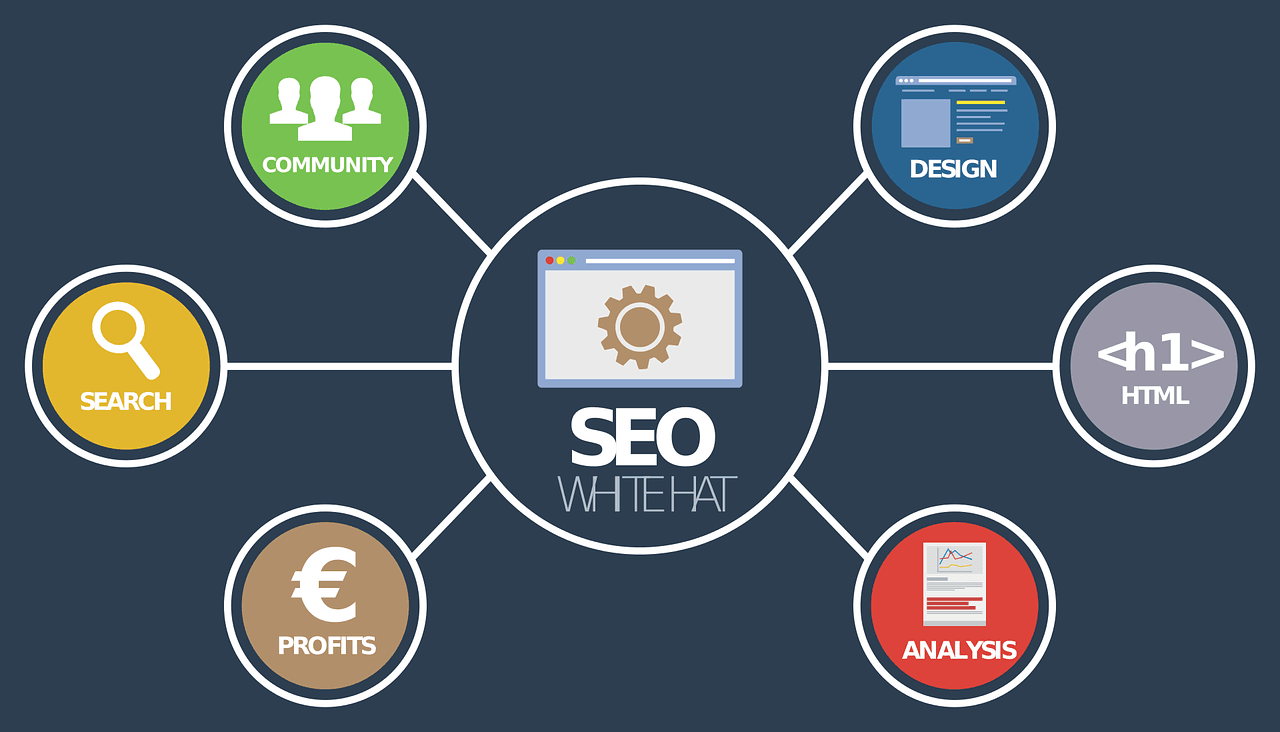This Article has been revised, edited and added to, by Poulomi Chakraborty.
- Understanding B2C vs. B2B SEO
- Optimizing Product Pages for SEO
- Improving Site Structure for Better SEO
- Leveraging Content Marketing for SEO
- Using Technical SEO Tactics to Enhance Your Site’s Performance
- Building High-Quality Backlinks
- Conclusion
In the bustling world of e-commerce, standing out from the crowd is not just a goal—it’s a necessity. With millions of online stores vying for attention, ensuring your website ranks high on search engines is critical. This is where SEO, or Search Engine Optimization, comes into play. For B2C (Business-to-Consumer) e-commerce websites, mastering SEO can mean the difference between thriving and merely surviving.
SEO involves optimizing your website to make it more attractive to search engines like Google. When done right, SEO can drive organic traffic to your site, increase sales, and boost your brand’s visibility. But SEO is not a one-size-fits-all strategy. What works for B2C websites can be vastly different from what works for B2B (Business-to-Business) websites.
In this article, we’ll delve deep into SEO strategies tailored specifically for B2C e-commerce websites. We’ll explore how to optimize your product pages, improve site structure, leverage content marketing, and use technical SEO tactics to enhance your site’s performance. But first, let’s set the stage by understanding why B2C SEO is unique and how it compares to B2B SEO.
Understanding B2C vs. B2B SEO

Target Audience and Buyer’s Journey
One of the fundamental differences between B2C and B2B SEO lies in the target audience and their buying journey. B2C e-commerce websites cater directly to consumers. The buying process is often quicker and more emotionally driven.
Consumers make decisions based on personal preferences, reviews, and immediate needs. They might browse for new clothes, gadgets, or home decor items and decide to purchase within minutes or hours.
In contrast, B2B websites target other businesses. The purchasing process is typically longer, involving multiple decision-makers and a more rational evaluation of the product’s return on investment. B2B buyers are looking for solutions that will benefit their company, requiring extensive research, proposals, and negotiations before making a decision.
Keywords and Content Strategy
Given these differences in the buyer’s journey, the keywords and content strategy for B2C e-commerce SEO must be finely tuned. B2C keywords are often shorter and more straightforward, focusing on product names, brands, and popular searches. For instance, keywords like “best running shoes,” “affordable smartphones,” or “luxury watches” are common in B2C SEO.
Content for B2C websites should be engaging, visually appealing, and geared towards quick decision-making. This includes product descriptions, customer reviews, and high-quality images or videos showcasing the products.
Blog posts, how-to guides, and buyer’s guides also play a crucial role in attracting and retaining customers by addressing their needs and interests.
On the other hand, B2B keywords tend to be longer and more complex, often reflecting the specific needs of businesses. Examples include “enterprise CRM software,” “cloud-based accounting solutions,” or “industrial-grade 3D printers.”
B2B content needs to be informative, authoritative, and tailored to different stages of the decision-making process. This includes whitepapers, case studies, detailed product specifications, and industry reports.
SEO Tactics and Goals
The goals of SEO for B2C e-commerce websites are often centered around increasing traffic, boosting sales, and enhancing brand visibility. As such, B2C SEO tactics focus on optimizing product pages, improving site speed, and creating engaging content that resonates with consumers.
Techniques like influencer partnerships, user-generated content, and social media integration are also highly effective in B2C SEO.
In contrast, B2B SEO aims to generate qualified leads, build long-term relationships, and establish thought leadership. B2B SEO tactics often involve creating in-depth content that showcases expertise, optimizing for long-tail keywords, and focusing on building high-quality backlinks from industry-specific sites.
Comparative Analysis
To put this into perspective, imagine two websites: one selling handmade jewelry directly to consumers (B2C) and another offering bulk raw materials for jewelry making to businesses (B2B).
The B2C site would focus on creating visually appealing product pages with enticing descriptions, customer reviews, and easy-to-navigate categories. It would also leverage social media platforms to showcase the jewelry through influencer collaborations and user-generated content.
Conversely, the B2B site would prioritize detailed product specifications, case studies demonstrating successful client partnerships, and industry insights through comprehensive blog posts.
Its keyword strategy would include terms like “wholesale jewelry supplies” or “bulk gemstone purchases,” aimed at attracting businesses looking for reliable suppliers.
Understanding these differences is crucial as we delve into specific SEO strategies for B2C e-commerce websites. By tailoring your approach to the unique characteristics of B2C SEO, you can effectively boost your online presence, attract more customers, and drive sales. Let’s explore these strategies in detail.
Optimizing Product Pages for SEO

Optimizing product pages is at the heart of any successful B2C e-commerce SEO strategy. Your product pages are where conversions happen, so it’s vital to ensure they are easily discoverable, informative, and engaging. Let’s dive into the key elements of optimizing product pages for SEO.
Crafting Compelling Product Titles and Descriptions
Product Titles
The product title is one of the first things both search engines and potential customers see. It should be clear, concise, and descriptive. Including relevant keywords in your product titles is crucial, as this helps search engines understand what your product is and match it with search queries.
For example, instead of a vague title like “Stylish Shirt,” use something more descriptive like “Men’s Slim Fit Casual Shirt – Blue.” This not only incorporates relevant keywords but also gives potential customers a clearer idea of what the product is.
Product Descriptions
Product descriptions should go beyond just listing features. They should tell a story, highlight benefits, and address potential customer concerns. A well-crafted product description can significantly improve your search engine rankings and conversion rates.
When writing product descriptions, consider the following tips:
- Incorporate Keywords Naturally: Use your target keywords, but avoid keyword stuffing. Aim for a natural flow that reads well.
- Focus on Benefits: Explain how the product will benefit the customer. For instance, instead of just saying “Made from high-quality cotton,” you could say, “Enjoy all-day comfort with our high-quality cotton shirt that’s perfect for any occasion.”
- Include Specifications: Provide detailed product specifications, such as size, material, color options, and care instructions. This helps customers make informed decisions.
- Use Engaging Language: Write in a conversational tone and use persuasive language to make the product more appealing.
- Highlight Unique Selling Points (USPs): Emphasize what sets your product apart from competitors. This could be special features, unique designs, or exclusive offers.
High-Quality Images and Videos
Visual content plays a crucial role in B2C e-commerce. High-quality images and videos not only attract customers but also help improve your SEO. Search engines consider user engagement metrics, such as time spent on a page, and multimedia content can enhance these metrics.
Images
Ensure your product images are high-resolution and showcase the product from multiple angles. Including zoom functionality allows customers to examine the product closely. Additionally, use image alt text to describe the images accurately and include relevant keywords. This helps search engines understand the content of the images and improves accessibility.
Videos
Product videos can significantly boost engagement and conversion rates. These can include demonstrations, unboxing videos, or customer testimonials. Videos provide a more immersive experience, helping potential customers understand the product better. Make sure to optimize video titles, descriptions, and tags with relevant keywords to enhance SEO.
User Reviews and Ratings
User reviews and ratings are powerful tools for both SEO and conversions. They provide social proof, build trust, and can even help your product pages rank higher in search results. Search engines value fresh, unique content, and user-generated reviews add to this.
Encourage satisfied customers to leave reviews and respond to them promptly. Positive reviews can improve your product’s credibility, while addressing negative reviews professionally shows that you value customer feedback and are committed to improving.
Structured Data Markup
Structured data markup, also known as schema markup, is a form of microdata that helps search engines understand the content of your web pages better. Implementing structured data on your product pages can enhance your search engine listings with rich snippets, which provide additional information directly in the search results.
For product pages, you can use schema markup to display information such as price, availability, ratings, and reviews. Rich snippets make your listings more attractive and informative, increasing the likelihood of clicks.
Mobile Optimization
With the increasing number of mobile shoppers, ensuring your product pages are mobile-friendly is essential. Google uses mobile-first indexing, meaning it predominantly uses the mobile version of your site for indexing and ranking. Therefore, a poor mobile experience can negatively impact your SEO and user engagement.
To optimize for mobile:
- Responsive Design: Ensure your website is responsive, meaning it adjusts seamlessly to different screen sizes.
- Fast Loading Times: Mobile users expect fast load times. Optimize images, use efficient coding practices, and leverage browser caching to improve page speed.
- Simplified Navigation: Make sure your site’s navigation is easy to use on mobile devices. This includes clear menus, easily tappable buttons, and minimal scrolling.
Internal Linking
Internal linking is the practice of linking to other pages within your website. It helps search engines understand the structure of your site and discover new content. For product pages, internal linking can guide users to related products, categories, or informative blog posts.
For example, if a customer is viewing a “Men’s Slim Fit Casual Shirt,” you could link to related products like “Men’s Casual Trousers” or a blog post on “How to Style Casual Outfits.” This not only improves the user experience but also helps distribute link equity across your site, boosting your overall SEO.
Improving Site Structure for Better SEO
A well-organized site structure is crucial for SEO success. It helps search engines crawl and index your site more efficiently, ensuring that all your pages are discoverable. Additionally, a clear and logical structure improves user experience, making it easier for visitors to navigate your site and find what they’re looking for. Let’s explore the key components of an effective site structure for B2C e-commerce websites.
Clear and Logical Hierarchy
A clear and logical hierarchy is the foundation of a well-structured website. This involves organizing your content in a way that makes sense to both users and search engines. Typically, this hierarchy is represented by a pyramid structure, with your homepage at the top, followed by category pages, sub-category pages, and finally, individual product pages.
Homepage
Your homepage serves as the central hub of your website. It should provide a general overview of what your site offers and link to the most important categories and pages. Make sure your homepage is well-designed, fast-loading, and includes clear navigation options.
Category Pages
Category pages group related products, making it easier for users to browse and for search engines to understand the site’s structure. Each category page should target specific keywords relevant to the products within that category. For example, if you sell clothing, you might have category pages like “Men’s Clothing,” “Women’s Clothing,” and “Kids’ Clothing.”
Sub-Category Pages
For larger e-commerce sites, sub-category pages can further refine the organization of your products. These pages provide more specific groupings within a broader category. For instance, under “Men’s Clothing,” you might have sub-categories like “Shirts,” “Trousers,” and “Jackets.” This additional level of structure helps users find what they’re looking for more quickly and improves SEO by allowing you to target more specific keywords.
Product Pages
Product pages are the final level of the hierarchy. Each product page should be optimized with relevant keywords, high-quality images, detailed descriptions, and user reviews, as discussed in the previous section. Ensure that these pages are easy to navigate and include links back to their respective categories and sub-categories.
Intuitive Navigation
Intuitive navigation is key to a positive user experience. If visitors can’t find what they’re looking for easily, they’re likely to leave your site, increasing your bounce rate and negatively impacting your SEO. Effective navigation should be simple, consistent, and comprehensive.
Main Navigation Menu
Your main navigation menu should be prominently displayed and include links to the most important pages on your site. This typically includes categories, sub-categories, and other essential pages like “About Us,” “Contact Us,” and “Customer Service.” Use clear, descriptive labels for each menu item to ensure users understand where each link will take them.
Breadcrumbs
Breadcrumbs are a secondary navigation aid that shows users their current location within the site’s hierarchy. They help users understand how they arrived at a particular page and provide an easy way to navigate back to previous levels. Breadcrumbs also benefit SEO by providing additional internal links and improving the crawlability of your site.
Footer Links
The footer is another valuable area for navigation links. While the main navigation menu should focus on primary categories and pages, the footer can include links to less prominent but still important pages, such as “Privacy Policy,” “Terms of Service,” “FAQs,” and “Shipping Information.” Including these links in the footer ensures they’re accessible from any page on your site.
URL Structure
An SEO-friendly URL structure is essential for both search engines and users. URLs should be simple, descriptive, and include relevant keywords. Avoid using long, complex URLs with unnecessary parameters or numbers.
Best Practices for URL Structure
- Keep URLs Short and Descriptive: Use clear, concise URLs that accurately reflect the content of the page. For example, “yourstore.com/mens-clothing/shirts” is preferable to “yourstore.com/category123/shirts.”
- Include Keywords: Incorporate relevant keywords into your URLs to improve search engine visibility. However, avoid keyword stuffing.
- Use Hyphens to Separate Words: Hyphens are preferred over underscores to separate words in URLs, as search engines recognize hyphens as spaces.
- Avoid Special Characters: Special characters like “#,” “&,” and “?” can complicate URLs and make them less user-friendly. Stick to alphanumeric characters and hyphens.
Internal Linking Strategy
Internal linking helps distribute link equity across your site and improves crawlability. A well-thought-out internal linking strategy ensures that all your pages are accessible and provides additional pathways for both users and search engines.
Linking to Related Products
Linking to related products on your product pages can keep users engaged and encourage them to explore more of your offerings. For example, on a product page for a “Men’s Slim Fit Casual Shirt,” you could include links to other related items like “Men’s Casual Trousers” or “Men’s Casual Shoes.”
Linking to Categories and Sub-Categories
Ensure that your product pages link back to their respective category and sub-category pages. This not only helps users navigate your site but also strengthens the hierarchical structure of your site for search engines.
Contextual Links in Blog Posts
If you have a blog, use it as an opportunity to link to relevant product pages. For example, a blog post on “Summer Fashion Trends” could include links to products featured in the article. This not only drives traffic to your product pages but also enhances the relevance and authority of your content.
XML Sitemap and Robots.txt
An XML sitemap is a file that lists all the pages on your website, helping search engines find and index your content more efficiently. Ensure your sitemap is up-to-date and includes all important pages. Submit your XML sitemap to Google Search Console and other search engines to facilitate the indexing process.
The robots.txt file is used to control which pages search engines can crawl. Ensure your robots.txt file is correctly configured to allow search engines to access important pages while blocking sensitive or low-value pages, such as admin pages or duplicate content.
Leveraging Content Marketing for SEO

Content marketing is a powerful tool for B2C e-commerce websites. It not only drives organic traffic to your site but also builds brand authority, engages customers, and enhances SEO.
By creating valuable, relevant content, you can attract and retain a clearly defined audience, ultimately driving profitable customer action. Let’s explore how to effectively leverage content marketing to boost your SEO.
Creating High-Quality Blog Content
Identifying Target Audience and Content Topics
Before you start creating content, it’s crucial to understand your target audience. Who are your ideal customers? What are their interests, pain points, and questions? Conducting audience research and creating buyer personas can help you tailor your content to meet their needs.
Once you have a clear understanding of your audience, brainstorm content topics that align with their interests and your products. Use tools like Google Keyword Planner, Ahrefs, or SEMrush to identify relevant keywords and topics with high search volume and low competition.
Writing Engaging and Informative Blog Posts
High-quality blog posts are the backbone of your content marketing strategy. They should provide value, answer questions, and solve problems for your audience. Follow these tips to create engaging and informative blog posts:
- Catchy Headlines: Your headline is the first thing readers see, so make it compelling. Use numbers, questions, and power words to grab attention. For example, “10 Summer Fashion Tips to Stay Cool and Stylish” or “How to Choose the Perfect Running Shoes.”
- Introduction: Start with a strong introduction that hooks readers and sets the stage for the rest of the article. Clearly state what the post will cover and why it’s valuable.
- Clear Structure: Use H2 and H3 headings to break up your content and make it easy to scan. Each section should cover a specific point and flow logically to the next.
- Visuals: Incorporate images, videos, infographics, and other visual elements to enhance your content. Visuals make your posts more engaging and can help explain complex concepts.
- Internal and External Links: Include links to other relevant content on your site (internal links) and reputable external sources. Internal links keep readers on your site longer, while external links build credibility and provide additional value.
- Call to Action (CTA): End each post with a clear CTA, encouraging readers to take the next step, whether it’s signing up for a newsletter, following you on social media, or checking out a product page.
Utilizing Video Content
Video content is incredibly engaging and can significantly boost your SEO. Videos can help explain your products, showcase customer testimonials, or provide useful tips and tutorials. Here’s how to make the most of video content:
Types of Video Content
- Product Demos: Show how your products work and highlight their features. This helps potential customers understand the product better and can increase conversions.
- How-To Guides: Create tutorials related to your products. For example, if you sell beauty products, you could create makeup tutorials or skincare routines.
- Customer Testimonials: Showcase satisfied customers talking about their experiences with your products. This builds trust and social proof.
- Behind-the-Scenes: Give customers a glimpse behind the scenes of your business. This could include manufacturing processes, office tours, or employee interviews.
Optimizing Videos for SEO
- Titles and Descriptions: Use relevant keywords in your video titles and descriptions to help them rank in search results.
- Thumbnails: Create eye-catching thumbnails that entice viewers to click on your videos.
- Transcriptions: Provide transcriptions of your videos to make them more accessible and improve their SEO. Search engines can index the text from transcriptions, making your videos more discoverable.
- Embedding Videos: Embed videos on relevant blog posts and product pages to enhance the content and keep visitors on your site longer.
Leveraging Social Media
Social media platforms are excellent channels for promoting your content and driving traffic to your website. By sharing your blog posts, videos, and other content on social media, you can reach a wider audience and improve your SEO.
Social Media Strategies
- Consistent Posting: Maintain a regular posting schedule to keep your audience engaged. Use social media management tools like Hootsuite or Buffer to plan and schedule posts in advance.
- Engagement: Interact with your followers by responding to comments, asking questions, and participating in conversations. This builds a sense of community and encourages more engagement with your content.
- Visual Content: Social media is highly visual, so use high-quality images, videos, and graphics to capture attention.
- Hashtags: Use relevant hashtags to increase the visibility of your posts. Research popular and trending hashtags in your industry to reach a broader audience.
- Influencer Collaborations: Partner with influencers in your niche to promote your products and content. Influencers have dedicated followings and can help you reach potential customers who might not be aware of your brand.
Creating Evergreen Content
Evergreen content is content that remains relevant and valuable over time. Unlike news articles or trend-based content, evergreen content continues to attract traffic long after it’s published. Examples include how-to guides, product reviews, and comprehensive resources.
Benefits of Evergreen Content
- Long-Term Traffic: Evergreen content can drive consistent traffic to your site for months or even years.
- SEO Value: High-quality evergreen content can earn backlinks and improve your search engine rankings.
- Content Repurposing: Evergreen content can be repurposed into different formats, such as videos, infographics, or social media posts.
Tips for Creating Evergreen Content
- Choose Timeless Topics: Focus on topics that will remain relevant to your audience over time. Avoid trends or news that will quickly become outdated.
- Update Regularly: Periodically review and update your evergreen content to ensure it remains accurate and up-to-date.
- Optimize for Keywords: Perform keyword research to identify relevant, long-tail keywords that have consistent search volume over time. Incorporate these keywords naturally into your content.
Guest Blogging and Influencer Outreach
Guest blogging and influencer outreach can significantly expand your reach and improve your SEO. By contributing content to reputable blogs and partnering with influencers, you can attract new audiences and earn valuable backlinks.
Guest Blogging
Identify high-authority blogs in your industry that accept guest posts. Pitch unique, high-quality content ideas that will resonate with their audience. When writing guest posts, include links back to relevant content on your site to drive traffic and improve your SEO.
Influencer Outreach
Partner with influencers who align with your brand and have a strong following in your niche. Influencers can create content featuring your products, share it with their audience, and provide authentic reviews. This not only increases your brand’s visibility but also generates high-quality backlinks that boost your SEO.

Using Technical SEO Tactics to Enhance Your Site’s Performance
Technical SEO focuses on optimizing the backend aspects of your website to improve its performance and ensure that search engines can crawl and index your site effectively. These tactics are essential for creating a solid foundation for your overall SEO strategy. Let’s explore the key technical SEO tactics that can enhance your B2C e-commerce website’s performance.
Improving Site Speed
Site speed is a critical factor for both user experience and SEO. Slow-loading websites can frustrate visitors and increase bounce rates, which negatively impacts your search engine rankings. To improve site speed, you need to optimize various elements of your website.
Compressing images reduces their file size without compromising quality, which helps pages load faster. Additionally, leveraging browser caching stores static files in a user’s browser, reducing load times for repeat visitors.
Implementing a Content Delivery Network (CDN) distributes your website’s content across multiple servers worldwide, ensuring faster load times for users regardless of their location.
Ensuring Mobile-Friendliness
With the rise of mobile internet usage, ensuring that your website is mobile-friendly is crucial. Google’s mobile-first indexing means that the mobile version of your site is considered the primary version for indexing and ranking.
A responsive design ensures that your website adjusts seamlessly to different screen sizes, providing an optimal user experience on both mobile and desktop devices. Simplified navigation and fast loading times are also essential for mobile users, as they expect quick and easy access to information.
Fixing Broken Links
Broken links can harm your site’s user experience and SEO. They create a frustrating experience for users who encounter “404 Not Found” pages and can lead to higher bounce rates.
Regularly auditing your website to identify and fix broken links is essential. Tools like Google Search Console or Screaming Frog can help you find broken links and redirect them to the appropriate pages, ensuring a smooth user experience and maintaining the flow of link equity throughout your site.
Optimizing XML Sitemap
An XML sitemap is a file that lists all the pages on your website, helping search engines crawl and index your content more efficiently. A well-optimized XML sitemap includes all important pages on your site and is regularly updated to reflect any changes.
Submitting your XML sitemap to Google Search Console and other search engines can facilitate the indexing process and ensure that all your content is discoverable.
Configuring Robots.txt

The robots.txt file is used to control which pages search engines can crawl and index. Properly configuring your robots.txt file ensures that search engines can access important pages while blocking sensitive or low-value pages, such as admin pages or duplicate content.
This helps prioritize the crawling of valuable content and prevents search engines from wasting crawl budget on irrelevant pages.
Enhancing Site Security with HTTPS
Site security is a crucial aspect of technical SEO. HTTPS (Hypertext Transfer Protocol Secure) encrypts the data exchanged between your website and its users, providing a secure browsing experience.
Google considers HTTPS as a ranking signal, meaning secure websites may rank higher in search results. Implementing HTTPS not only enhances your site’s security but also builds trust with your customers, encouraging them to complete purchases on your site.
Implementing Structured Data Markup
Structured data markup, also known as schema markup, is a form of microdata that helps search engines understand the content of your web pages better. By implementing structured data on your product pages, you can enhance your search engine listings with rich snippets, which provide additional information directly in the search results.
For e-commerce websites, structured data can display details like price, availability, ratings, and reviews, making your listings more attractive and informative. This can increase click-through rates and improve your overall SEO performance.
Reducing Duplicate Content
Duplicate content can confuse search engines and dilute your site’s authority. It can occur for various reasons, such as having multiple URLs for the same page or copying product descriptions from manufacturers.
To avoid duplicate content issues, ensure that each page on your site has unique content. Using canonical tags can also help indicate the preferred version of a page to search engines, consolidating link equity and preventing potential SEO penalties.
Optimizing URL Structure
An SEO-friendly URL structure is essential for both search engines and users. URLs should be simple, descriptive, and include relevant keywords. Avoid using long, complex URLs with unnecessary parameters or numbers.
A clear and concise URL structure helps search engines understand the content of your pages and makes it easier for users to navigate your site.
Enhancing Crawlability
Crawlability refers to the ease with which search engines can access and index your website. To enhance crawlability, ensure that your site’s architecture is well-organized and that all important pages are easily accessible. Internal linking helps search engines discover new content and understand the relationship between different pages.
Additionally, regularly auditing your site for crawl errors using tools like Google Search Console can help identify and fix issues that may hinder search engines from indexing your content.
Building High-Quality Backlinks

Backlinks, or inbound links, are links from other websites that point to your site. They are a crucial factor in search engine rankings, as they signal to search engines that your site is authoritative and trustworthy.
Building high-quality backlinks can significantly improve your SEO and drive organic traffic to your B2C e-commerce website. Let’s explore effective strategies for acquiring high-quality backlinks.
Creating Link-Worthy Content
The foundation of any successful backlink strategy is creating high-quality, link-worthy content. This type of content provides value to your audience and is more likely to be shared and linked to by other websites.
To create link-worthy content, focus on producing in-depth, informative, and engaging pieces that address your audience’s needs and interests.
For example, comprehensive guides, industry reports, and original research can attract attention and earn backlinks from other sites. Similarly, creating visually appealing content, such as infographics and videos, can encourage other websites to link to your resources as a valuable reference.
Guest Blogging
Guest blogging is an effective way to build backlinks and establish your authority in your industry. By contributing high-quality articles to reputable blogs in your niche, you can reach a wider audience and earn valuable backlinks to your site.
When pitching guest post ideas, ensure that your content aligns with the target blog’s audience and offers unique insights or valuable information.
When writing guest posts, include links to relevant content on your site naturally within the article. Avoid overly promotional content, as this can be off-putting to readers and blog editors. Instead, focus on providing value and demonstrating your expertise.
Building Relationships with Influencers and Industry Leaders
Building relationships with influencers and industry leaders can lead to valuable backlink opportunities. Engage with influencers in your niche by sharing their content, commenting on their posts, and participating in industry discussions.
Over time, these interactions can lead to collaborations, guest blogging opportunities, and mentions on their websites, all of which can generate high-quality backlinks.
Networking with industry leaders can also open doors to other backlink opportunities, such as being featured in industry roundups, expert interviews, or collaborative projects.
Leveraging Social Media
Social media platforms are excellent channels for promoting your content and attracting backlinks. By sharing your blog posts, infographics, videos, and other valuable content on social media, you can increase their visibility and reach a wider audience.
Engaging with your followers, participating in relevant discussions, and using popular hashtags can further amplify your content’s reach.
When your content gains traction on social media, it is more likely to be noticed and linked to by other websites, bloggers, and industry influencers. Encourage social sharing by including social sharing buttons on your blog posts and other content.
Participating in Online Communities and Forums
Participating in online communities and forums related to your industry can help you build relationships and earn backlinks. Contribute valuable insights, answer questions, and share your expertise in communities such as Reddit, Quora, and industry-specific forums. When appropriate, include links to relevant content on your site that provides additional value to the discussion.
However, be mindful of community guidelines and avoid spamming links. Focus on building trust and establishing yourself as a knowledgeable and helpful member of the community.
Creating and Promoting Original Research
Original research and data-driven content can attract significant attention and earn backlinks from other websites. Conduct surveys, analyze industry trends, or compile data on relevant topics, and present your findings in an engaging format.
Original research is often cited by other bloggers, journalists, and industry experts, leading to valuable backlinks.
To maximize the reach of your research, promote it through your blog, social media channels, email newsletters, and outreach to relevant websites and influencers in your industry.
Monitoring and Recovering Lost Backlinks
It’s essential to monitor your backlink profile regularly and recover any lost or broken backlinks. Tools like Ahrefs, SEMrush, and Moz can help you track your backlinks and identify any that have been removed or are no longer pointing to your site.
When you discover lost backlinks, reach out to the webmasters of the linking sites and request that they restore the link. Provide them with the correct URL and explain the value of linking to your content. In some cases, offering updated or improved content can encourage webmasters to reinstate the link.
Conclusion
Mastering SEO for B2C e-commerce websites involves a multifaceted approach that includes optimizing product pages, improving site structure, leveraging content marketing, employing technical SEO tactics, and building high-quality backlinks. By focusing on these areas, you can enhance your site’s visibility, drive organic traffic, and ultimately increase sales. It’s essential to stay updated with the latest SEO trends and continuously refine your strategies to stay ahead of the competition.
Regularly analyzing and measuring your SEO performance ensures that you can make data-driven decisions and optimize your efforts for maximum impact. Implementing these comprehensive SEO strategies will not only boost your search engine rankings but also provide a better user experience, fostering long-term customer loyalty and business growth.
READ NEXT:





















